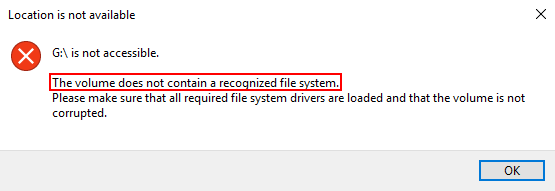As a result of formatting, all information in the processed section disappears. Most often it happens involuntarily or the data on the hard drive is deleted without the user’s knowledge. What if my formatted media contains valuable information that needs to be restored immediately?
Accidentally formatting a hard drive or an external memory inserted into a computer is a situation that no one likes to think about, and which sooner or later can happen to anyone. Non-specialists associate the format of the disk with the ultimate, irreversible disposal of data, but in reality it is far from the truth.
Can I Recover Data after Format?
Formatting refers to an initialization operation performed to disk to make it available for data storage. The implication is that if a disk has not been formatted yet, it can’t be used to save data. However, you can also choose to re-format the disk drive anytime you want after data had been saved to that drive.
In fact, file recovery from formatted/damaged hard drive is not always practical. For instance, if a hard drive has been sent to manufactures for low-level formatting, files in it will be gone for good; in contrast, if the drive is performed with high-level formatting, there is still a possibility for successful data recovery (this will be discussed later in part 3).
Let’s see how to recover from a formatted hard drive.
Recover Files from Formatted Hard Drive
2 Situations of Drive Formatting
Situation 1
Imagine this: one of your drives saves very important files, but when you try to open it and access files, you failed. The system prompts that “you need to format this disk before you can use it”. At this critical moment, you can’t just agree to “Format disk” in order to use the drive as usual. It will do harm to files in that disk. Unfortunately, some of you do format the drive and lose some important files.
Situation 2
Another situation is that: when you find your hard drive becomes RAW or volume doesn’t contain a recognized file system, you will choose to reformat it to fix the problem.


All those could happen all of a sudden. What should you do to recover formatted drive?
My suggestions are:
- Stop making any changes to the formatted hard drive
- Install MiniTool Power Data Recovery, a user-friendly data recovery program, to recover data from formatted hard drive (this also works with formatted removable devices).
Recover Data from a Formatted Hard Drive in 4 Steps
Step 1: you should install the software after downloading and then launch it to start the recovery.
Step 2: on the left side of the main interface, there are four options provided for you. You should select “Hard Disk Drive” and specify the formatted hard drive on the right side (when putting cursor onto a drive, you’ll see its drive letter which makes it easy to confirm whether this is the one you want or not).
Step 3: You have 2 choices to scan your formatted hard disk.
- One is double clicking on the target disk.
- And the other is pressing “Scan” button after the disk is specified.
Then, you will see more and more files are found during the scan and they’ll be listed in the software interface. At this time, you should browse them carefully.
Step 4: you can end the scan anytime by pressing the “Stop” button, as long as you find all the data you need are found by the software. After that, you should check all the items you want to recover from the formatted drive and press the “Save” button to store them to another drive.
Please note that if you’re using the Trial Edition, you can’t recover any data indeed; all you can do is preview the data on formatted hard drive. To recover them out, you need a license for a full edition.
Top Recommendation
Sometimes, you may have formatted the hard drive by using diskpart (the Windows built-in program). In this case, you can also use this software to recover data lost by diskpart clean easily.
Classification of Hard Drive Formatting
In general, formatting is divided into two types:
- Low-level formatting
- High-level formatting
If there is no special instruction, the hard drive formatting usually refers to high-level formatting process while the floppy disk formatting often includes both formatting types. Read the following paragraphs to know clearly about low-level formatting and high-level formatting.
Low-level Formatting
Low-level formatting was used to refer to the operation of dividing cylinders, tracks, and sectors. But currently, this kind of formatting generally refers to the zero-fill operation of the hard drive. Strictly speaking, the low-level formatting includes the following steps:
- Divide a disk into several cylinders and tracks.
- Divide each track into several sectors.
- Divide each sector into several parts, such as identification section, GAP area, and DATA
When low-level formatting is required?
In fact, the low-level formatting work has been performed to each hard drive by manufacturers when it leaves the factory, so usually, users don’t need to do such a thing. It should be noted that the low-level formatting is a loss operation, which has a negative impact on the service life of the hard drive.
As a result, lots of manufacturers recommend that this kind of formatting should be your last resort unless your encounter the following situations:
- A hard drive is badly corrupted that the operating system cannot recover it.
- You need to get rid of almost any data-related problem on the drive (such as viruses and corrupted partitions).
- It is necessary to hide bad sectors by telling the drive to remap them to its collection of spares.
How to perform low-level formatting?
There are 3 ways to perform low-level formatting.
- The CMOS of many motherboards provides the low-level formatting function and it is usually embedded in HDD Low Level Format option. If you have this option on your motherboard, you can directly choose Hard Disk Low Level Format Utility for low-level formatting.
- Of course, there’re many motherboards which have no such feature. In this case, you had better make use of the hard drive management/low-level formatting program provided by your hard drive manufacturers, instead.
- What’s more, if your hard drive is a standard one, you can also turn to third-party tools when low-level formatting is needed.
High-level formatting includes the following steps:
- Rewrite the corresponding region of the partition table in Master Boot Record.
- Divide certain disk partition space to store information that is used for file management (such as file allocation table and file directory table, according to users’ selection on the file system)
In other words, high-level formatting refers to removing data on hard drive, generating boot sector information, initializing FAT and marking logical bad sectors.
This kind of formatting is generally involved in the OS reinstallation process. Since MBR is not going to be rewritten, there is a great possibility that virus exists. But don’t worry, the MBR virus can be completely cleared by using antivirus software or executing fdisk/mbr in DOS.
When high-level formatting is required?
- Initialize drive: a new disk drive can’t be put into use before formatting. So if users want to use a new drive to store and manage data, they need to format it.
- Kill virus: since computer virus spread widely through the internet, users can get easily attacked by it. If users want to kill the virus in certain drive and make it clean, they’d better format the drive rather than just using antivirus software.
- Change file system/drive size: once a drive is set, its file system and size are determined. When users need to change any of them, they have to format the drive again. However, we’d like to share the good news with them – they can achieve those easy purposes by using MiniTool Partition Wizard
I mentioned before without reformatting. - Format inaccessible drive: the commonest case is that users open a drive, only to find it can’t be accessed. To further use it, users have no choice but to format this drive.
How to perform high-level formatting?
There are also 3 common ways to format a drive in Windows.
One: format with Partition Wizard
Step 1: launch MiniTool Partition Wizard, select the drive which needs to be reformatted and choose “Format Partition” function in left action panel.
Step 2: you can choose to input a partition label and select a file system & cluster size in “Format Partition” window. After that, click “OK” to go back to the main interface.
Step 3: click “Apply” button in the upper left corner and press “Yes” in the pop-up warning window to confirm changes.
Two: format in Windows Explorer
Step 1: click on the “Computer” icon on the desktop to enter.
Step 2: select the drive you plan to format. Afterwards, right click on it and choose “Format…” from the pop-up menu to enter following formatting window.
Step 3: here, you can set a file system for the drive waiting to be formatted and change the allocation unit size (but I recommend you keep the default value if there’s no special need). Also, you can choose to create a label for this drive or just skip this part. Now, please click on the “Start” button to continue.
Step 4: a prompt window will appear at this time, warning users that the formatting operation will erase all data. If you are sure to format the drive, please click on “OK”.
Three: format in Windows Disk Management
Step 1: open Computer Management and choose “Disk Management” under “Storage”.
Step 2: right click on the unallocated space and choose “New Simple Volume…” to start. Then, click “Next” in each interface of “New Simple Volume Wizard” to continue. In this process, you are allowed to set volume size, drive letter, file system, allocation unit size, and volume label. At last, click “Finish”.
Step 3: check in Disk Management and you’ll find the drive you created just now.
Part 4 – Verdict
Some of you may ask what if you have already formatted a drive by mistake. As for the question, whether it’s possible to recover formatted drives
, I gave a positive answer in the above content. Anyone can use the data recovery software I recommend to recover formatted hard drive files easily.
But, please think twice before you finally decide to high-format your drive which saves business/personal files. Remember, though you are able to recover files from formatted hard drive in most cases, it’s not a 100% sure thing. Protection is always more important than recovery.
News From
 MiniTool Solution
MiniTool Solution Category: Data Recovery Services Profile: MiniTool Solution Ltd. is a software development company based in Canada. As a dedicated software development company, MiniTool Solution Ltd. provides customers with complete business software solutions in the data recovery and partition management industry.
This email address is being protected from spambots. You need JavaScript enabled to view it.








